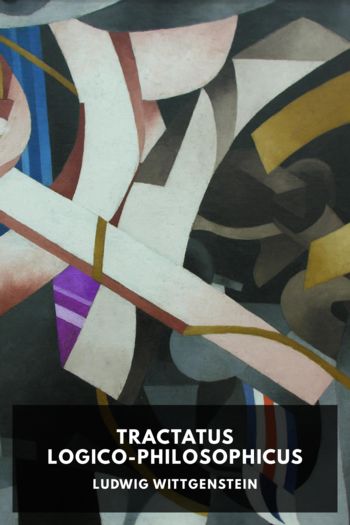Tractatus Logico-Philosophicus - Ludwig Wittgenstein (top 10 ebook reader TXT) 📗

- Author: Ludwig Wittgenstein
Book online «Tractatus Logico-Philosophicus - Ludwig Wittgenstein (top 10 ebook reader TXT) 📗». Author Ludwig Wittgenstein
The essential business of language is to assert or deny facts. Given the syntax of language, the meaning of a sentence is determined as soon as the meaning of the component words is known. In order that a certain sentence should assert a certain fact there must, however the language may be constructed, be something in common between the structure of the sentence and the structure of the fact. This is perhaps the most fundamental thesis of Mr. Wittgenstein’s theory. That which has to be in common between the sentence and the fact cannot, he contends, be itself in turn said in language. It can, in his phraseology, only be shown, not said, for whatever we may say will still need to have the same structure.
The first requisite of an ideal language would be that there should be one name for every simple, and never the same name for two different simples. A name is a simple symbol in the sense that it has no parts which are themselves symbols. In a logically perfect language nothing that is not simple will have a simple symbol. The symbol for the whole will be a “complex,” containing the symbols for the parts. (In speaking of a “complex” we are, as will appear later, sinning against the rules of philosophical grammar, but this is unavoidable at the outset. “Most propositions and questions that have been written about philosophical matters are not false but senseless. We cannot, therefore, answer questions of this kind at all, but only state their senselessness. Most questions and propositions of the philosophers result from the fact that we do not understand the logic of our language. They are of the same kind as the question whether the Good is more or less identical than the Beautiful” (4.003).) What is complex in the world is a fact. Facts which are not compounded of other facts are what Mr. Wittgenstein calls Sachverhalte, whereas a fact which may consist of two or more facts is a Tatsache: thus, for example “Socrates is wise” is a Sachverhalt, as well as a Tatsache, whereas “Socrates is wise and Plato is his pupil” is a Tatsache but not a Sachverhalte.
He compares linguistic expression to projection in geometry. A geometrical figure may be projected in many ways: each of these ways corresponds to a different language, but the projective properties of the original figure remain unchanged whichever of these ways may be adopted. These projective properties correspond to that which in his theory the proposition and the fact must have in common, if the proposition is to assert the fact.
In certain elementary ways this is, of course, obvious. It is impossible, for example, to make a statement about two men (assuming for the moment that the men may be treated as simples), without employing two names, and if you are going to assert a relation between the two men it will be necessary that the sentence in which you make the assertion shall establish a relation between the two names. If we say “Plato loves Socrates,” the word “loves” which occurs between the word “Plato” and the word “Socrates” establishes a certain relation between these two words, and it is owing to this fact that our sentence is able to assert a relation between the persons named by the words “Plato” and “Socrates.” “We must not say, the complex sign ‘aRb’ says ‘a stands in relation R to b’ ”; but we must say, “That ‘a’ stands in a certain relation to ‘b’ says that aRb” (3.1432).
Mr. Wittgenstein begins his theory of Symbolism with the statement (2.1): “We make to ourselves pictures of facts.” A picture, he says, is a model of the reality, and to the objects in the reality correspond the elements of the picture: the picture itself is a fact. The fact that things have a certain relation to each other is represented by the fact that in the picture its elements have a certain relation to one another. “In the picture and the pictured there must be something identical in order that the one can be a picture of the other at all. What the picture must have in common with reality in order to be able to represent it after its manner—rightly or falsely—is its form of representation” (2.161, 2.17).
We speak of a logical picture of a reality when we wish to imply only so much resemblance as is essential to its being a picture in any sense, that is to say, when we wish to imply no more than identity of logical form. The logical picture of a fact, he says, is a Gedanke. A picture can correspond or





Comments (0)